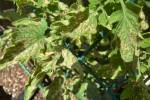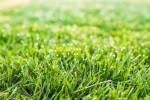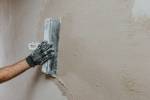Seeds soaked in fertilizer will ‘explode’ with growth
Q: I wanted to ask you about my newly planted fescue lawn. A few months ago, I asked you to give me a step-by-step project in replacing the old lawn in the house I just moved into. I have followed the steps and have so far seen nice results. I laid seed down on the 17th and, from the picture I sent to you, I hope you'll agree things are shaping up nicely. There are sure to be spots that I didn't seed as even as others, so my question is, when/how do I go back and fill in those areas? Any other opinion from what you see in the picture?
A: It looks good. The open areas between grass plants are to be expected when it is first growing from seed. If it is open like it is in your picture, you will see bare ground. That is normal when it has not yet been mowed or had a chance to fill in. I would not worry about it.
The grass grows straight up when it first germinates. As you mow, the grass plant will begin to tiller, or create side shoots, that increase the density of the lawn.
But, if you are talking about distances between plants of several inches or more, then you will need to reseed those bare spots. If you reseed the entire lawn, then you will waste a lot of seed. Try to focus on those spots that are open.
Don't worry about spots that have scattered grass plants in them. They will fill in. If this were me, I would now apply another light application of fertilizer. But use only straight nitrogen if you applied a complete fertilizer at the time of planting. This would be a very light application.
If you use 21-0-0, I would put down about 2 pounds for every 1,000 square feet. I would then (if you have time) soak some seed in water (put a little bit of 21-0-0 in the water) for a few hours, drain it and let it dry overnight. In the morning, when the seed is dry to the touch, broadcast the seed in the bare areas.
If you soak the seed and let it dry too long, you will kill the seed. The seed has to imbibe water (like a sponge) but let the surface of the seed dry so you can spread it; but do not let it get too dry so the seed loses its imbibed water. The seed soaking with a little nitrogen will cause the seed to "explode" with growth. You will see what I mean if you do it.
By the way, this will work with most garden seeds as well including garlic cloves, corn seed, onion sets, etc. The trick is to not soak them more than a few hours or they will die of oxygen starvation but long enough to imbibe water and start the germination process.
Q: I have been finding small holes in my raised beds in Kingman that are about the size of a 50 cent piece and about 2 inches deep. I have dug into some of them and found nothing. Is something crawling out or am I just not seeing what is happening?
A: Fifty cent piece! Oh you are revealing your age! Unless they still use them in Kingman.
It is hard to say, just offhand. I was trying to relate it to the time of year and it is a bit late for emergence from the soil of one of the June beetle grubs, aka white grubs. That might have been a bit earlier, unless you see June beetles flying now.
They also can be compost "worms" or grubs some people talk about being in their compost piles. They like to lay their eggs in decomposing plant material so that the grubs have something to feed on while they are maturing.
If compost was added to the garden, the grubs could have been deposited in the garden with the compost. In large numbers these can feed on plant roots in the garden.
Another possibility could be a tarantula hawk burrow. This is a large, dark colored waspy-looking flying insect, usually with reddish-brown wings. They can carry a prey down in the hole, deposit an egg in the living prey and cover the hole. The young devours the prey, alive, inside the hole. The adult emerges from the hole leaving it open again.
It is nothing to worry about and a good guy for the garden and normally avoids humans if given a chance. All of these holes are about the size of a 50 cent piece.
Bob Morris is a horticulture expert living in Las Vegas; he is on special assignment in the Balkh Province, Afghanistan, for the University of California, Davis. Visit his blog at xtremehorticulture.blogspot.com.























